|
① The Old Tollhouse |
|
|
On the bank of the river Rhine next to the Eulengasse, you find the Old Tollhouse, which was built around 1500 AD. Its existence goes back to the sovereignty of the community of nons from Essen over the county of Breisig.
The nons were granted the privilege of raising toll for the use of the road. For this reason the tollhouse was built on the banks of the river Rhine, in addition to the tollgates already established (Köln gate - north gate; Koblenz gate - south gate) in teh wall surrounding Breisig since 1280 AD. Leaning walls and numerous flood markers on the front of this beautiful timber frame house testifiy to its great age.
|
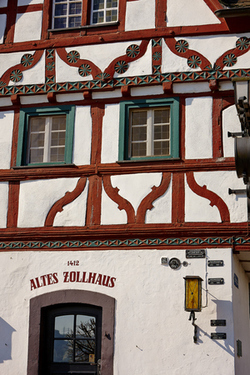
|
|
Continuation of tour:
Continue on the Promenade to „Alter Zollhof“
|
|
|
|
|
|
② Customs Table |
|
|
There’s an old customs table in front of the “Alter Zollhof” restaurant.
This customs table, hewn from basalt, was originally located at the
northern entrance gate, the Kölner Tor. Customs rights were held by
the territorial sovereign/abbess of the imperial free-confessional religious community of noblewomen; it was a road toll that had to be paid. According to history, Napoleon once sat at this customs table and drank a glass of Elzenberger red wine (wine from the wine region Elzenberg, Bad Breisig at that time) when he visited this spa town during the French occupation. The goblet he drank from still exists today.
|
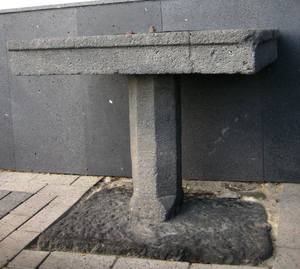 |
|
Continuation of tour:
Further back to Schmittgasse, left in the direction of the B9, after
approx. 150 m on the left side
|
|
|
|
|
|
③ The Dinget Pillar |
|
|
This unique tombstone for the honourable Johann-Hugo Dinget, ad-
viser of the Archbishop of Trier, has been placed in the Schmittgasse.
For many years the monument stood in the cemetery of Brohl, where
this gentleman, the owner of Brohleck Castle, had initially been buried. It consists of a square socket and a cylindrical pillar, which still bears the original inscription. “Here rests in peace Johann-Hugo Dinget, former adviser of the Archbishop of Trier, born on the 18th of December 1767, died on the 9th of December 1827. Peace to his ashes.” Johann-Hugo Dinget belonged to a Freemanson fraternity which regulary came together for meetings in Breisig.
|

|
|
Continuation of tour:
B9 left and through the underpass, cross to the other side of the street
|
|
|
|
|
|
④Church St. Mary Assumption |
|
|
St. Mary´s was built from 1717 to 1725 AD and with its square tower and the double baroque top it is the landmark of Bad Breisig.
The baroque pilaster portal with curved gable and 1718 written on the lintel beam leads into the church. On the right hand side you might note the enlargement, erected in 1977. The church is a single nave with five axis and a high gothic hall. It is accompanied by a crown of buttresses whose curved covers indicate the Baroque style. The high altar was built during the first half of the 18th century.
A counterbalance to the rich choir furnishing is the gallery with the noble organ pipes. The organ pipes were acquired in 1959 from a Protestant church in Aurich (North Germany). A separate shrine inside the church holds a valuable silver cross relic from the Donatus chapel of the Templar fraternity. Another item of interest inside the shrine is a fragment of a Roman votive altar that was found on the bank of the Vinxt brook. The facade has only recently been artistically restored and returned to its original condition with the financial support of public institutions. At the same time, the old organ was replaced by a new one. Organ builder Rowan West, Altenahr, made an instrument in north German baroque style, thereby creating stylistic and tonal harmony between the organ and the baroque style of the organ frame and the remaining decor of the church.
|

|
|
Continuation of tour:
Please cross the B9 via the pedestrian tunnel and walk down Biergasse for 200 m towards a rather large building on the right hand side.
|
|
|
|
|
|
⑤
The "Schultheissenhaus" |
|
|
The house at 28 Biergasse was built in 1670 by the sheriff family Meurers as an official office and residence; the wrought iron numerals on the outer facade provide the evidence for this. The family served as sheriffs from 1588 to 1794 – this is equivalent to the position of the mayor (Bürgermeister) today. The initials of Wilhelm Meurers are
engraved in the sides of the window grates. The Heimat- und Museumsverein Bad Breisig e.V. moved into the right wing of the ground floor in 2015, where it opened a city and local history museum. It displays exhibitions on various historic topics. All other premises are rented out privately.
|
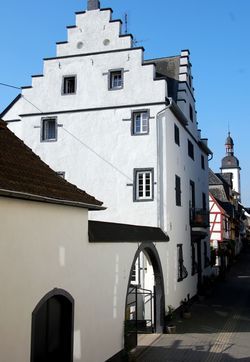
|
|
Continuation of tour:
Rhine-Promenade on the right, to the spa gardens
|
|
|
|
|
⑥Spa Gardens
|
|
|
The Spa Gardens was established by the Danish consulate general Oehme. The trees planted come from all over the world; if you take a walking tour in the park you can find out about their origin from the small information panels.
The city’s tourist information centre is located in the Spa Gardens.
|

|
|
Continuation of tour:
Please proceed through the park in the direction of the B9
|
|
|
|
|
|
⑦
The old Town Hall |
|
|
In 1873/1874 the old Town Hall was constructed at 31 Koblenzer Straße. It was used as the administrative centre of Breisig. An eye
catcher is the classical pillar on the entrance. In 1905 an annex provided additional office space. In 1988 the administration moved to the Bachstraße and the new owners Mr. and Mrs. Ringel opened a doll museum with more than 400 dolls, amongst them a few rare items from the second half of the 19th century. Today, the house is privately owned.
|
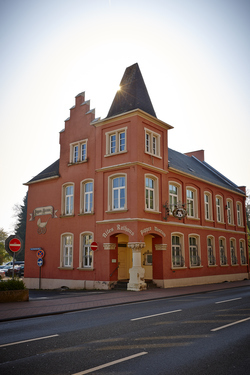
|
|
Continuation of tour:
Please cross the B9 and proceed towards a small visitors park
|
|
|
|
|
⑧Mausoleum Art Nouveau
|
|
|
In 1911/12 Albert Mertés, a hat manufacturer from cologne, built the mausoleum on Breisig’s former cemetery (1805-1966), in memory of his daughter Mimi Mertés who died very young.
The mausoleum has a slate roof with a glass dome. The panelling and the floor are made of marble. The four sarcophagi are made from blocs of tuff, which is a vulcanic rock.
Albert Mertés died in 1924 in Berlin. The mausoleum was the last resting place of his daughter Mimi, his son Albert Peter, his young grandson Walter and of himself.
|

|
|
Continuation of tour:
Please follow the B9 in the direction Koblenz, pass through the pedestrian tunnel to the other side of the road, continue for another 200 m and turn left.
|
|
|
|
|
⑨
The Templar Court
|
|
|
The Templar Court at 45 Koblenzer Strasse, raised by members of the
Templar fraternity, was mentioned for the first time in 1215. In 1245
the Donatus Chapel was built on the Rhine side of the Templar court
in which the fraternity retained a precious relic of the Holy Cross.
Today, this cross is kept in St. Mary´s Church. The red cross on white
background, symbol of the fraternity, was taken over by the Knights of
Malta and can still be seen today on the frames of the windows facing
the “Tempelgasse”. During the Thirty Year War (1618-1648) the Templar Court was destroyed and subsequently rebuilt in 1657.
|
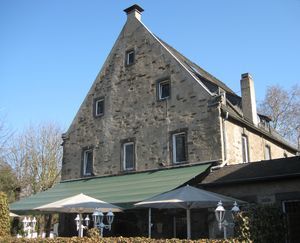
|
|
Continuation of tour:
Please proceed into the direction of Koblenz for about 400 m
|
|
|
|
|
⑩ The Protestant Church
|
|
|
The Protestant ChurchOn the 2nd of June 1901the corner stone of the ‘Church of Christ’ was placed on Koblenzer Straße opposite the railway station, and on 8th of December 1902 the community celebrated the inauguration of the church.
For many years they had to use the chapel of Rheineck Castle, made available to them by the owner, the Baron of Bethman-Hollweg.
The church is a brick building faced with local tuff. In 1905 the organ was purchased from the Church of Remagen, where it had been installed in 1872. It was fully restored on the occasion of its 100 year anniversary in 2001.
|
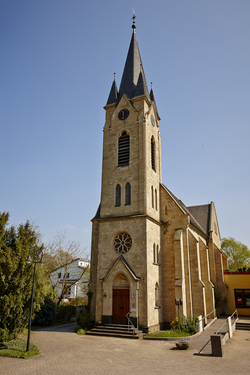
|
|
Continuation of tour:
Cross over to the other side of the road, B9 in the direction of Bonn, until the railway station, through the underpass, then right into Brunnenstraße, pass by the tennis courts.
|
|
|
|
|
⑪Geyr Hot Spring/Roman Thermal Bath
|
|
|
In 1936 Johann Martin Schuh accomplished the construction of the Spa building named Geyrsprudel (Albert-Mertés-Straße 11), and put to good use the warm spring which had previously been discovered and drilled by Baron Geyr from Schweppenburg in 1914.
In 1961 his son Willy Schuh installed an indoor thermal bath at the same place, and the first indoor thermal wave bath in Europe in 1969 opened here. Another improvement was achieved when in 1991 the “Römer Thermen” opened business, offering an indoor thermal pool, physiotherapeutic applications, far reaching sauna facilities and even a fitness studio.
In 2010 the Römertherme was converted into a spa and health oasis.
|

|
|
|
|
Additional places of interest:
|
|
|
|
|
|
⑫
Old school in Oberbreisig |
|
|
In 1839 a boy school was established in Oberbreisig.
An enlargement
had to be added in 1873 to accommodate a girl school.
The building was in use as a school until 1973.
|

|
|
|
|
|
⑬ St. Viktor´s Church |
|
|
The parish church St. Viktor, first documented in 1041AD, has always been a landmark in Oberbreisig. The church in its present shape was built in the late Romanesque period of the Rhineland between 1220 and 1240. The interior originates mainly from the 17th and 18th century.
On the east wall of the northern aisle you may find an oil painting
dating back to the 15th century (Holy Barbara, Katharina and Doro-
thea). In addition, the church is decorated with frescos from the 14th and 15th century.
|
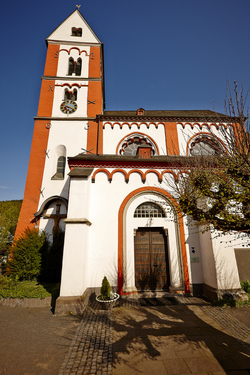
|
|
|
|
⑭Chapel of St. Borroméus
|
|
|
The district of Rheineck on the north of the Vinxt brook belonged to the governance of Breisig in the south to the county of Rheineck Castle.
In 1718 a chapel was built which was dedicated to St. Karl Borroméus. On the lava stone frame which surrounds the wooden door of the southern entrance you may find the date “Anno 1718”. In the interior a statue of St. Barbara, who is the patron saint of all miners, reminds us that people from Rheineck worked in the iron ore mines north of the Vinxt brook and later in the basalt quarries south of the brook for their living.
|
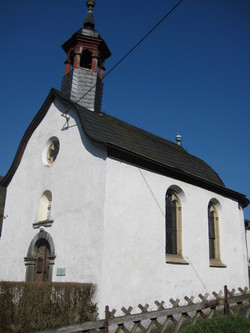
|
|
|
|
|
⑮
Burg Rheineck |
|
|
Rheineck Castle was built in the 11th century by the palatinate counts
of the Rhineland.
After several destructions and rebuilds a university professor from Bonn and the later Prussian education minister Moritz August von Bethmann-Hollweg in 1832 purchased the castle and had it rebuilt and restored to its former medieval shape by the famous architect Johann Claudius von Lassaux.
Today, the castle is in private ownership and is not accessible to the general public.
|
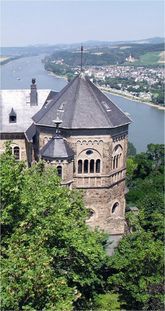
|
|
|
|
|
Celtic fortified Settlement "Auf dem Hahn" |
|
|
An Iron age settlement dated from 600-200 BC, fortified by a ring wall
for protection and defence. A similar settlement is to be found on the
“Reuterslay” near Rheineck Castle.
|
|